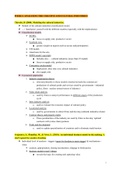WEEK 1: ANALYZING THE CREATIVE AND CULTURAL INDUSTRIES
Throsby, D (2008). Modeling the cultural industries.
❖ Models of the cultural industries classification model.
❖ —> familiarize yourself with the different models (especially with the implications):
❖ Classification models
➢ DCMS,
■ focus on supply side, productive sector
➢ Symbolic text,
■ greater weight on aspects such as access and participation
➢ UIS model,
➢ Americans for the arts,
➢ WIPO model: copyright
■ Includes also … cultural industries (more than CCmodel)
■ focus on supply side, productive sector
➢ Concentric circles model
■ Implication: does only core cultural industries
■ also supply side
❖ 6 economic approaches
1. Industry organization theory
a. relevant primarily to those models oriented towards the commercial
production of cultural goods and services (used by governments - industrial
policy, firms - analyse attractiveness of industry)
2. Value chain analysis
a. used by firms to analyze performance in different stages of the production
cycle
3. Inter-industry analysis
a. used to evaluate the economic impact of cultural policy
4. Locational analysis
a. used by governments to attract firms and develop (cultural) industries cluster
5. Contract theory and property rights
a. These peculiarities of the industry are used by firms to develop ‘optimal’
contracts with (value chain) partners
6. Trade and development
a. used to explain specialization of countries and to eliminate trade barriers
Svejenova, S., Planellas, M., & Vives, L. (2010). An individual business model in the making: A
chef’s quest for creative freedom.
❖ Individual level of analysis - triggers (quest for freedom is main trigger) & mechanisms -
value
➢ creation, appropriation, sharing mechanisms, slippage to third parties
➢ business model reveal 3 things
■ reveals the logic for creating and capturing value
1
, ■ reveals the organization’s approach to renewal
■ enhances understanding of organization’s operations
➢ four periods of Ferran Adria’s business model:
● 1. employee pre-stage.
● 2. owner-manager.
● 3. entrepreneur.
● 4. leader (in industry/world)
■ main mechanism: change mechanism (creative response → disruptive) and
value mechanism (everything to do with value: value capture and value
sharing and value slippage to third parties)
Poisson-de Haro, S., & Montpetit, D. (2012). Surviving in times of turmoil: Adaptation of the
Théâtre Les Deux Mondes business model.
❖ Business model = understanding the logic of the firms for renewal as well as creating and
capturing value
❖ Turmoil internal & external can develop suddenly or occur gradually
➢ overcome by adjusting business model
➢ external/market turmoil: funding, or low interest of external stakeholders
➢ internal/organizational turmoil: lack of available resources (HRM/ access to important
networks) dual leadership (financial and artistic departments, different objectives)
■ internal turmoil can lead to external turmoil
❖ Components of a business model
➢ customer value proposition,
➢ key resources (people),
➢ key processes (people),
➢ profit formula (WTP))
■ for cultural organizations both key resources and key processes are people
related → competitive advantage
❖ New business model is needed when changes are needed to elements of your existing model
WEEK 2: ORGANIZATIONAL DESIGN
Lampel, J., Lant, T., & Shamsie, J. (2000). Balancing act: Learning from organizing practices in
cultural industries.
❖ What organizational form is best suited to production in the CI?
❖ 5 tensions:
➢ artistic value vs entertainment value
■ has implications for how cultural production is organized (e.g. gov subsidies)
➢ product differentiation vs market innovation
■ category spanning (combining categories)
➢ demand analysis vs market consumption
■ push or pull?
➢ vertical integration vs flexible specialization
■ vertical integration often leads to control of market, at loss of flexibility
2
, ■ strategic alliance
➢ individual inspiration vs creative system
■ individual: HRM
■ collective/system: organization culture, collaboration
➢ → tensions are widespread, and balanced in many ways
Lampel, J., & Shamsie, J. (2003). Capabilities in motion: New organizational forms and the
reshaping of the Hollywood movie industry.
❖ How specific organizational forms come with specific benefits and drawbacks
❖ Industry structure changed (bureaucratic (studio era) → flexible (post-studio era))
❖ Resources: inputs for achieving superior performance
❖ Capabilities: routines and practices used to effectively manage resources
➢ Mobilizing capabilities = routines needed to identify and commit resources
■ Mobilizing capabilities contribute to the commercial success of movies (H1 =
confirmed)
■ empirical context: pre-production phase (resource bundle, problem, solution)
➢ Transforming capabilities = routines that drive and regulate the process of using
resources to obtain a finished product of a desirable quality
■ transforming capabilities contribute to the commercial success of movies (H2
= confirmed)
■ empercial context: production phase
❖ Certain organizational forms facilitate the use of certain specific capabilities
❖ ! Adoption of new organizational forms increased the relative contribution of mobilizing
capabilities for the success of movies (H3 = confirmed)
❖ ! Adoption of new organizational forms decreased the relative contribution of transforming
capabilities for the success of movies (H4 = confirmed)
Starkey, K., Barnatt, C. and Tempest, S. (2000). Beyond Networks and Hierarchies: Latent
Organizations in the U.K. Television Industry.
❖ organizational structure UK TV before 1990:
➢ television scriptwriting → production → publishing → broadcasting
❖ Changes in competitive landscape:
➢ 1990 broadcasting act (rule: at least 25% independent)
➢ new entry of publisher-broadcasters
➢ new entry of independent program makers
➢ → as result: vertical disintegration → change organizational form
❖ 3 main ways
➢ hierarchy (vertical integration)
■ assured level of quality, but high cost / low flexibility
■ all part of same organization
➢ market
■ cost reduction / flexible, but no quality assurance
➢ network (establishing relationships)
3





